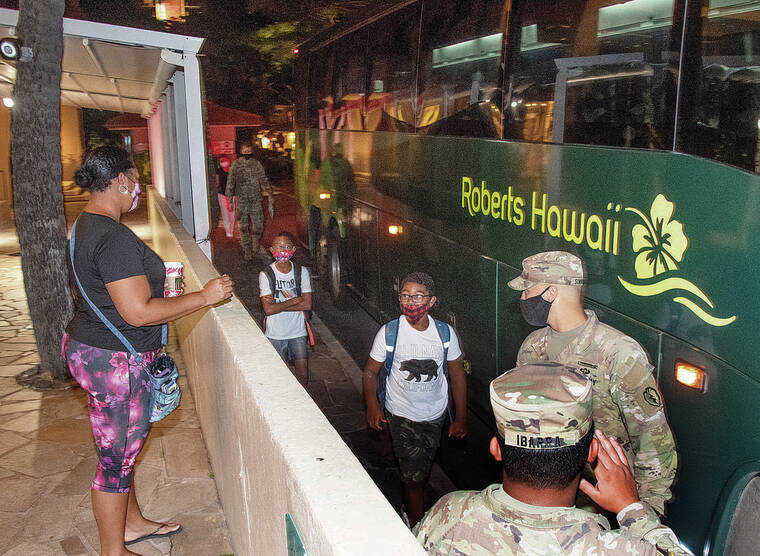Exhausted students and families struggling with commuting from Waikiki hotels to school. Student learning time lost. Thousands of dollars meant for instruction spent instead on emergency bottled water and makeshift hand-washing setups. Frustrated teachers who keep wondering, When will this end?
These are among the heretofore untold stories of the personal cost at the seven Hawaii public schools directly affected by the Red Hill water contamination crisis as it approaches a third month.
About a dozen teachers spoke out publicly for the first time Monday about what they have witnessed and felt since the running water at their schools was declared off-limits due to possible fuel contamination. The virtual forum was organized by the Hawaii State Teachers Association.
“We’re having (student) meltdowns, student behaviors — it’s just a lot of stress for families,” Michele Sasaki, a kindergarten teacher at Hickam Elementary School, said of those temporarily relocated from military housing to hotels 8 to 10 miles away.
Of the children in her charge, Sasaki said, “They’re tired, they’re hungry. I had one student falling asleep on his desk today because he strolled in late, because they had to drive from Waikiki … (in) what looked to be his pajamas, poor thing. You know, bed head.” Another child in the classroom next door had to leave so early for his commute that he didn’t have breakfast and begged for food from his teacher, she said.
School funds once intended for computer upgrades at Hickam have had to go to temporary hand- washing stations, bottled water, wipes and hand sanitizer. Early in the crisis, it was costing her school around $1,000 per week, Sasaki said.
“Now we gotta sell off our computers. … Our 10-year-old computers — they’re so old, they don’t update. But too bad. We spent our money on, you know, trying to get safe water,” she added with a wry laugh.
The affected schools currently advised to avoid using their taps: Red Hill, Nimitz, Pearl Harbor, Pearl Harbor Kai, Iroquois Point, Hickam and Mokulele elementary schools.
Multiple requests by the Honolulu Star-Advertiser to the state Department of Education to visit the campuses have been denied or unanswered.
Interim state schools Superintendent Keith Hayashi last week estimated emergency supplies so far have cost the schools about $15,000, and said the Education Department is working with the military to seek “possible reimbursement.” But several teachers in the HSTA forum, including union President Osa Tui Jr., said that figure sounds low.
Teaching hours lost
Several teachers said the many changes to the school day caused by the water crisis add up to hours taken away from time when they could be teaching and students could be learning — a difficult sacrifice when school data show the pandemic is already causing widespread learning loss.
The temporary ban on using the campus taps for hygiene, cooking and drinking means children are washing their hands at portable outdoor sinks and makeshift classroom sprayers, which several teachers said some of their littlest students have had a hard time operating, so they require teacher assistance.
Pearl Harbor Kai teacher Leilani Ngumezi said when the hand-washing stations sometimes unexpectedly run out of water, “Here I am, unscrewing (16-ounce) water bottles and dumping water in as fast as I can. … We can’t plan for when the water is going to run out and when we need more.”
Some teachers in the virtual forum said their schools had to relax their tardiness policies to accommodate students stuck in traffic from Waikiki, extend grace for relocated families with no computers for the children to do homework, and suspend school uniform rules because many families are unable to wash student uniforms at the hotels.
Cafeterias at some schools are still serving mostly previously frozen food such as pizza and have not returned to regular meal service, contrary to the report delivered by Hayashi to the board last week.
For students who were excited at first to go the hotels, months later “it just tugs on your heart when they say, ‘I just want to go home,’” said Mokulele teacher Roberta Akiu.
Tui said the teachers’ testimony suggests that officials at the DOE and military might not be adequately in touch with the suffering on the ground at the schools. From officials “we’ve heard that, ‘Oh, there’s school buses, so no need to worry,’ but we didn’t hear about the 5:30 in the morning that the kids get picked up,” Tui said. “We’ve heard, ‘Oh, they’re in the hotels,’ but we didn’t hear others are not in the hotels. We didn’t hear there’s a lack of washing machines and kids have to go to school in their pajamas. We have heard that our cafeterias are in service, but (in the forum) we learned there are some that are not back in service and they are continuing to serve pizza and chicken nuggets every day to these poor students.”
State Rep. Aaron Johanson voiced thanks for the dedicated educators at the affected schools: “You’re probably part of the only normalcy these kids and families are experiencing right now.”
A confidential survey Opens in a new tab is being conducted by the public health team from the state Department of Health and the Centers for Disease Control and Prevention. Anyone affected by the petroleum contamination in the Navy’s Joint Base Pearl Harbor-Hickam drinking water system is encouraged to participate. Questions will cover water use, health symptoms and medical care sought, effects on children and pets, and medical history. The deadline is Feb. 7.
The Hawaii Youth Climate Coalition is collecting student signatures on scrolls that read, “We, the youth of Oahu, support the removal of the Red Hill fuel tanks and our right to clean water.” The coalition intends to combine them into one large signature scroll to present at hearings.

